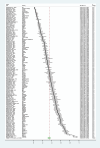Patient-physician communication on herbal medicine use during pregnancy: a systematic review and meta-analysis
- PMID: 38448037
- PMCID: PMC10916170
- DOI: 10.1136/bmjgh-2023-013412
Patient-physician communication on herbal medicine use during pregnancy: a systematic review and meta-analysis
Abstract
Introduction: Lack of transparent communication between patients and physicians regarding the use of herbal medicine (HM) presents a major public health challenge, as inappropriate HM use poses health risks. Considering the widespread use of HM and the risk of adverse events, it is crucial for pregnant women to openly discuss their HM use with healthcare providers. Therefore, this systematic review and meta-analysis aims to estimate the pooled prevalence of pregnant women's HM use and disclosure to healthcare providers and to examine the relationship between HM disclosure and various maternal and child health (MCH) measures.
Methods: A systematic search of five databases was conducted for cross-sectional studies on HM use during pregnancy published from 2000 to 2023. Data extraction followed a standardised approach, and Stata V.16.0 was used for data analysis. Also, Spearman's correlation coefficient was calculated to examine the association between use and disclosure of HM and various MCH indicators.
Results: This review included 111 studies across 51 countries on the use of HM among pregnant women. Our findings showed that 34.4% of women used HM during pregnancy, driven by the perception that HM is presumably safer and more natural than conventional medical therapies. However, only 27.9% of the HM users disclosed their use to healthcare providers because they considered HM as harmless and were not prompted by the healthcare providers to discuss their self-care practices. Furthermore, a significant correlation was observed between HM disclosure and improved MCH outcomes.
Conclusion: Inadequate communication between pregnant women and physicians on HM use highlights a deficiency in the quality of care that may be associated with unfavourable maternal outcomes. Thus, physician engagement in effective and unbiased communication about HM during antenatal care, along with evidence-based guidance on HM use, can help mitigate the potential risks associated with inappropriate HM use.
Keywords: Health education and promotion; Health policy; Maternal health; Public Health; Systematic review.
© Author(s) (or their employer(s)) 2024. Re-use permitted under CC BY-NC. No commercial re-use. See rights and permissions. Published by BMJ.
Conflict of interest statement
Competing interests: None declared.
Figures





Similar articles
-
Disclosure of herbal medicine use to health care providers among pregnant women in Nepal: a cross-sectional study.BMC Complement Med Ther. 2020 Nov 10;20(1):339. doi: 10.1186/s12906-020-03142-9. BMC Complement Med Ther. 2020. PMID: 33172473 Free PMC article.
-
Assessing the safety and use of medicinal herbs during pregnancy: a cross-sectional study in São Paulo, Brazil.Front Pharmacol. 2023 Sep 19;14:1268185. doi: 10.3389/fphar.2023.1268185. eCollection 2023. Front Pharmacol. 2023. PMID: 37795036 Free PMC article.
-
The future of Cochrane Neonatal.Early Hum Dev. 2020 Nov;150:105191. doi: 10.1016/j.earlhumdev.2020.105191. Epub 2020 Sep 12. Early Hum Dev. 2020. PMID: 33036834
-
Association between pregnancy intention and late initiation of antenatal care among pregnant women in Ethiopia: a systematic review and meta-analysis.Syst Rev. 2020 Aug 20;9(1):191. doi: 10.1186/s13643-020-01449-9. Syst Rev. 2020. PMID: 32819428 Free PMC article.
-
Herbal medicine use and predictors among pregnant women attending antenatal care in Ethiopia: a systematic review and meta-analysis.BMC Pregnancy Childbirth. 2020 Mar 12;20(1):157. doi: 10.1186/s12884-020-2856-8. BMC Pregnancy Childbirth. 2020. PMID: 32164603 Free PMC article.
References
-
- Heitmann K, Nordeng H, Havnen GC, et al. . The burden of nausea and vomiting during pregnancy: severe impacts on quality of life, daily life functioning and willingness to become pregnant again–results from a cross-sectional study. BMC Pregnancy Childbirth 2017;17:75. 10.1186/s12884-017-1249-0 - DOI - PMC - PubMed
-
- Aljoher AM, Alsaeed MA, Alkhlfan MA. Pregnant women risk perception of medications and natural products use during pregnancy in Alahsa, Saudi Arabia. Egyptian Journal of Hospital Medicine 2018;70:13–20. 10.12816/0042956 - DOI
Publication types
MeSH terms
Substances
LinkOut - more resources
Full Text Sources
